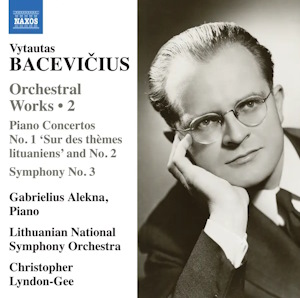
Vytautas Bacevičius (1905-1970)
Orchestral Works Volume 2
Piano Concerto No. 1 ‘Sur des thèmes lituaniens’ Op.12 (1929)
Piano Concerto No. 2 Op.17 (1933)
Symphony No. 3 Op.33 (1944)
Gabrielius Alekna (piano)
Lithuanian National Symphony Orchestra/Christopher Lyndon-Gee
rec. 2021, Lithuanian National Philharmonic Hall, Vilnius, Lithuania
Naxos 8.574414 [74]
Vytautas Bacevičius’s difficult life spent in a sort of exile made him a true international. Born in the Polish city of Łódź, he chose at an early age to move to Lithuania with his father. That was his real home, and he never felt settled anywhere else he went. In 1927 he moved to Paris, where he developed a career as an outstanding pianist, and where his sister Grażyna Bacewicz lived. When the Second World War broke out, he was stuck in Buenos Aires and could not get back to Europe. A little later he took the American citizenship, but he never fully adjusted.
Bacevičius wrote Symphony No.3 soon after his arrival in New York but it was never performed. The first of four movements begins with a mysterious Moderato maestoso and then turns into Allegro molto. But it moves around, sometimes unconvincingly, between that and a slower tempo never settling on a clear form or direction. The enchanting Andante doloroso movement has a unique and even more charming harp cadenza in its middle section, slightly distantly recorded. The main melody may remind you of Mussorgsky. The scherzo is delightfully scored with pizzicato strings.
The finale highlights what may be called a finale problem. It is directionless for much of its course until the composer quotes, I feel successfully, The Stars and Stripes Forever to signal that he felt determined to settle into his new home. On the other hand, the march-like use of timpani and cymbal clashes in the outer movements is rather annoying. One can but wonder, had they have had the opportunity, what the American public would have made of the work.
Bacevičius, a successful concert pianist, unsurprisingly composed four piano concertos – see a review of the third. Here we have the first two. No.1 weighs in at just fifteen minutes. It is subtitled, in somewhat odd French, Sur des thèmes lituaniens. Its three movements run into each other, and apparently the orchestra at the recording sessions knew many of the tunes. The best I can say of the work is that it is young man’s music. It does little more than show off the pianist, and things get loud. I could not come to grips with its loose structure and unmemorable ideas.
Piano Concerto No.2 again employs traditional-type melodies, but now the composer names them in the score. The work, at twenty-six minutes, has four connecting movements. For much of its course, this is a successful and enjoyable concerto, but the finale, surely too long and heavy-handed in its orchestration, can be wearying on the ear. Conductor Christopher Lyndon-Gee supplies an extensive, useful and fascinating booklet essay. He has made a considerable study of Bacevičius. He talks a little of influences both musical and philosophical on the composer, and lists an odd combination of Scriabin, Alexander Mosolov, Honegger and Prokofiev. That seems just about right to me.
One has to admire Naxos for believing in this composer. Compliments to the Lithuanian orchestra (who must be new to this music) and especially to Lyndon-Gee for studying and editing these scores. I assume that there is more to come. For example, Bacevičius composed six symphonies, most of them in America. Generally, his music remained unheard and undiscovered. It is a pity that he could not have pushed his music more.
So, I have caveats about the quality of the music, but I would also be fascinated to hear more if and when more volumes come out. They should reveal further intriguing facets of this overlooked figure.
Gary Higginson
Buying this recording via a link below generates revenue for MWI, which helps the site remain free




















